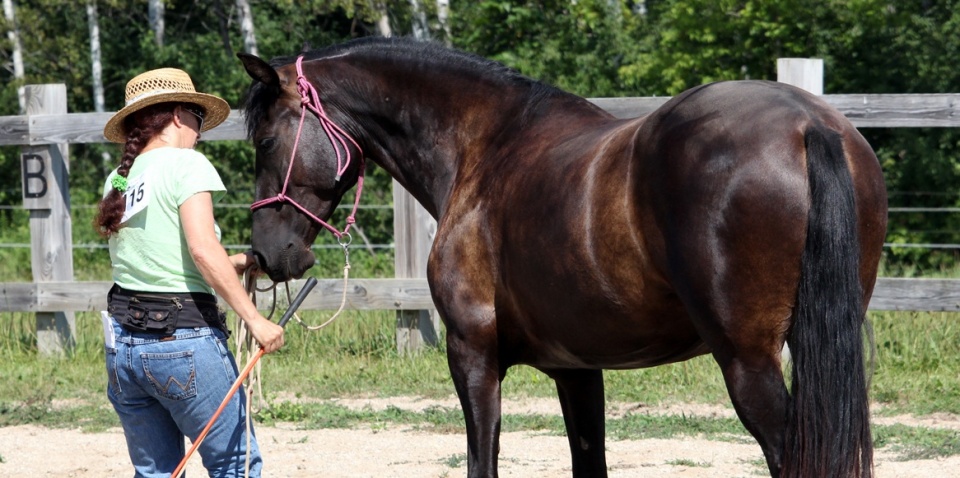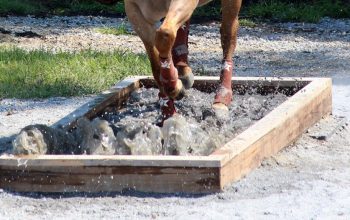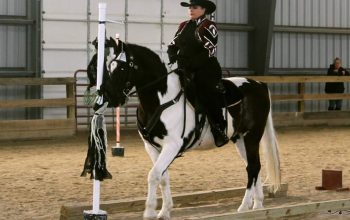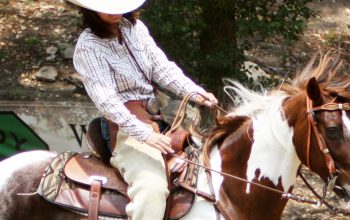
By Rachel Miller
My horse, Tulla, and I are honored to have become 2019 Equine Trail Sports Midwest Champions as Equine Warrior and Warrior – Adult. When I heard about Equine Trail Sports, I immediately liked everything about it. First of all, the competitors are being judged on accomplishing tasks that any horse and rider should be able to do: back around a barrel, sidepass over a pole, run a clipper over commonly groomed areas, etc. The points generated by successful completion of these tasks accumulate over the lifetime of not only human competitors but also equine competitors. As total points reach predetermined levels, awards are given to horse and/or rider. How fun is that: a horse can win prizes independently of its human partner?

However, for me the most appealing part of Equine Trail Sports is knowing that my horse has what it takes to excel in this type of competition. After all, she was raised from birth to understand and execute such maneuvers required by the sport. Tulla’s dam, Bella, was my first horse as an adult. I grew up riding horses, but, after I went off to college, there was a 25-year gap before I bought Bella. Bella was a beautiful, unpapered mare that I bought for all the wrong reasons. To the casual observer, she appeared as a gorgeous Polish Arabian, however, for me, she was quite the challenge to ride initially. Even though she was six years old when I bought her, she only had 90 days of training, spending the majority of those six years as a petting horse for an elderly couple. As a trail horse, she was unconfident with a high spirit level which led to a lot of shying as well as other challenging behaviors. In fact, to get out of the round pen, I bought my husband the best trail horse ever and made him learn to ride just to be able to follow him down the trail with my jigging, excitable mare. During my 10-year journey with her, she led me down many trails in pursuit of the knowledge of horsemanship. I told my husband so many times that Bella would never have been so challenging to ride if I had raised her.
Enter Tulla. There is an old saying: when the teacher is ready, the student will appear. There is another saying: be careful what you wish for. When Bella developed life-threatening complications of melanoma, a cancer predominantly in gray horses, I did everything possible in veterinary medicine to try to save her. I decided to breed her to soften the inevitability of her loss. I always loved Andalusians and was very attracted to the promotion of the breed by the International Andalusian Horse and Lusitano Association which permitted the registration of half Andalusians. I was very fortunate to have an excellent veterinarian whose skill set allowed unlimited choice of any available Andalusian stallion. I chose Conquistador XII not only for his beautiful features and gentle nature, but also his homozygous black genetics. The foal, if black, would have less chance of having melanoma. When Tulla was born, she may have had her sire’s color and wavy hair, but her tiny face was a perfect replica of her dam, and she had Bella’s temperament to go with it!

I imprinted Tulla at birth following the procedure as outlined by Dr. Robert Miller. Bella turned out to be an amazingly trusting mare when I played with her baby. I could lead Tulla clear around the other side of the barn out of the eyesight of her mother, and neither baby nor momma would neigh for one another or express any other sign of anxiety.

Tulla and I climbed on pedestals, walked through water boxes and over teeter totters and tarps, played with hoses, giant beanbags and curtains of plastic ribbons for 20 minutes, then I would return her to her mother un-missed. In fact, in the pasture, Tulla spent most of her day going on adventures with her super confident three year-old half sister, providing Bella even less opportunity to instill in her foal her wary, hypervigilant nature. Tulla’s early learning experiences have made her into the confident and curious horse she is today.
Fortunately, Equine Trail Sports finally expanded into the Midwest, and 2019 was our first year to compete. As Tulla was only four years old, I found the ETS tasks helpful in showing me areas that Tulla still needed development as well as providing direction and motivation. In fact, when I found out that IAHLA awarded a beautiful ribbon to the ETS high-point Andalusian, Tulla and I were up for the challenge, and Tulla successfully achieved that award for 2019 as well.
Now we are looking forward to the beginning of the 2020 ETS events patiently waiting for our opportunity to show our new skills we have been working on all winter. We are up for the challenge!





